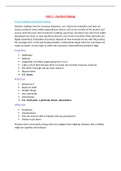Unit 2 – Decision Making
Three Categories of Decision-Making
Decision making is key for consumer behaviour, our criteria for evaluation and how we
choose products varies widely depending on factors such as the novelty of the product and
service and how much risk is involved in making a purchase. Decisions may stem from habits
developed over time, to new situations wherein a lot of risk is involved. Many decisions are
highly automated. Evaluation of products depend on how involved we are with the product,
the message and / or the purchasing situation, involvement ranges from low, purchases are
made via inertia, to very high, in which the consumer’s bond with the product is high.
Cognitive
Deliberate
Rational
Sequential, we follow stages going from 1 to 2
Takes a lot of time because there is usually risk involved, financial, social etc
We think it through and do more research
Big purchases
E.G. house,
Habitual
Behavioural
Based on habit
Smaller things
Very automatic
Unconscious
E.G. tooth picks, a particular brand, subscriptions
Affective
Emotional,
Instantaneous
May not even be able to explain why you purchased it
Harder to pin down
Products don’t necessarily only go into one category they might go between, like a holiday
might be cognitive and habitual
, Stages in Cognitive Consumer Decision Making
There are several steps to the decision making process. It begins with problem recognition,
wherein we know action needs to be taken. This may be due to a product being damaged or
just wanting something new. Once the problem has been recognised and the consumer sees
that it warrants action they will begin the information search process. Searching may be
limited to just scanning your memory, to extensive field search where multiple sources will
be consulted in order to get as much information as possible. Then consumers will evaluate
alternatives, with the options being considered consisting of their evoked set, with items
sharing the same characteristics and therefore get grouped together. When the decision is
made it is done through a few rules, non-compensatory rules eliminate alternatives that
don’t fit the necessary criteria and compensatory rules, used in high-involved products,
allows consumers to consider both the pros and cons before coming to the best choice.
After this is the consumer’s post-purchase evaluation, they decide whether they like it or
not, this then influences their next decision making process.
Problem Recognition
Realising what the problem is
Information Search
Look for information to solve the problem
Evaluation of Alternatives
Looks at many alternatives
Different websites or stores
Looks at different prices
Looks for different brands
Product Choice
The choice will be narrowed down and the choice will be made
Outcome
May be happy or disappointed with the choice
Might show off to friends
Step 1: Problem Recognition
Occurs when the consumer sees a difference between their current state and ideal
state, there’s a difference between what you have and what you want to have
May not necessarily be a problem might be an opportunity
1) Need recognition: actual state declines
2) Opportunity recognition: ideal state moves upward




